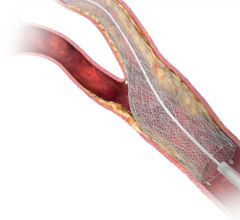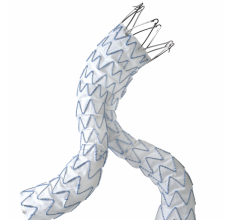
June 2, 2022 — Elixir Medical, a developer of innovative, drug-eluting cardiovascular devices, announced print publication of a study in the latest issue of Cardiovascular Revascularization Medicine that showed that the DynamX Coronary Bioadaptor System, when uncaged, enabled rotational motion similar to natural vessels and reduced peak implant stress by 70 percent. The DynamX Bioadaptor is the first drug-eluting coronary artery implant that adapts to vessel physiology by incorporating flexible “uncaging elements” into its design.
Throughout the cardiac cycle, coronary arteries are exposed to forces with every heartbeat, including stretching, bending, twisting, expansion, torsion and pulsatility. Conventional drug-eluting stents (DES) “cage” the vessel, preventing natural coronary movement of the vessel, leading to adverse clinical events.1 Long-term studies of DES have shown adverse event rates of 20 percent at five years2 and 40 to 50 percent at 10 years.3 Clinical studies have shown that a conventional drug-eluting stent prevents positive adaptive remodeling,4 vessel compliance, pulsatility and vasomotion in response to the body’s changing blood flow needs.5,6 Stents have also been shown to cause vessel straightening, which is associated with increased major adverse cardiac events (MACE).7
The DynamX rotation study showed that vessel segments treated with bioadaptors demonstrated significantly more rotational motion when uncaged. Computational modeling also indicated that peak rotational stress for the bioadaptor decreased by 70 percent with uncaging of the bioadaptor. Restoration of rotational movement of the artery is important for all lesions and may be particularly important in long, diffuse lesions and in the left anterior descending artery (LAD), which exhibits greater torsion than the rest of the coronary tree.
The study encompassed an analysis of IVUS imagery from 20 patients participating in the DynamX Mechanistic Clinical Study acquired post-implantation and at nine to 12 months follow-up. Investigators included Mayank M. Kansal, MD, Beata Wolska, MD and Mladen I. Vidovich from the University of Illinois, Chicago, and Stefan Verheye, MD, from ZNA Cardiovascular Center, Middleheim, Antwerp, Belgium.
“The DynamX Mechanistic Clinical Study previously showed that the bioadaptor enabled positive adaptive remodeling, preserving the vessel lumen to accommodate disease progression, as well as a return towards baseline vessel angulation and a strong safety profile. This recent analysis now demonstrates the ability of the device to twist along with the vessel’s natural motion, and in doing so, subsequently reduce vessel stress. These are exciting characteristics that have the potential to improve patient outcomes,” said Dr. Vidovich.
By incorporating unique “uncaging elements” in its metallic implant design, the DynamX Bioadaptor allows for the restoration of natural artery function and movement8 essential to cardiovascular performance. The DynamX Bioadaptor is designed to achieve sustained superior clinical outcomes by adapting to vessel physiology and restoring positive adaptive remodeling, pulsatility and rotation.
The DynamX Bioadaptor supports the coronary artery with radial strength and acute performance similar to DES during healing. However, unlike DES, the bioadaptor uncages the artery after its polymer coating resorbs over six months. This uncaging enables the device to restore the artery’s ability to move naturally in response to the body’s needs.
For more information: https://elixirmedical.com/
References:
- Ding, Zhaohua, and Morton H. Friedman. Dynamics of human coronary arterial motion and its potential role in coronary atherogenesis. J Biomech Eng. 2000;122(5): 488-492.
- Iqbal J, Serruys PW, Silber S, et al. Comparison of zotarolimus- and everolimus-eluting coronary stents: final 5-year report of the RESOLUTE all-comers trial. Circ Cardiovasc Interv. 2015;8(6):e002230. doi:10.1161/CIRCINTERVENTIONS.114.002230
- Kufner S, Joner M, Thannheimer A, Hoppmann P, Ibrahim T, Mayer K, et al. Ten-year clinical outcomes from a trial of three limus-eluting stents with different polymer coatings in patients with coronary artery disease: results from the ISAR-TEST 4 randomized trial. Circulation. 2019; 139:325–333. doi: 10.1161/CIRCULATIONAHA.118.038065.
- Nakamura M, Yock PG, Bonneau HN, et al. Impact of peri-stent remodeling on restenosis: a volumetric intravascular ultrasound study. Circulation. 2001;103(17):2130-2132. doi:10.1161/01.cir.103.17.2130
- Maier, W, Windercker, S, Kung, A, et al. Exercise-Induced Coronary Artery Vasodilation Is Not Impaired by Stent Placement. Circulation. 2002; 105(20): 2373-2377. doi: 10.1161/01.cir.0000016360.97819.44
- Hamilos, M, Sarma, J, Ostojic, M, et al. (2008). Interference of Drug-Eluting Stents With Endothelium-Dependent Coronary Vasomotion Evidence for Device-Specific Responses. Circulation. Cardiovascular interventions. 1. 193-200. 10.1161/CIRCINTERVENTIONS.108.797928.
- Gyöngyösi M, Yang P, Khorsand A, Glogar D. Longitudinal straightening effect of stents is an additional predictor for major adverse cardiac events. Austrian Wiktor Stent Study Group and European Paragon Stent Investigators. J Am Coll Cardiol. 2000;35(6):1580-1589. doi:10.1016/s0735-1097(00)00570-2
- Verheye S, Vrolix M, Montorfano M, Zivelonghi C, Giannini F, Bedogni F, et al. Twelve-month clinical and imaging outcomes of the uncaging coronary DynamX bioadaptor. EuroIntervention 2020;16;e974-e981
Related content:
First Patient Treated in Elixer Dynamx Coronary Bioadaptor Stent Technology


 November 24, 2025
November 24, 2025 









